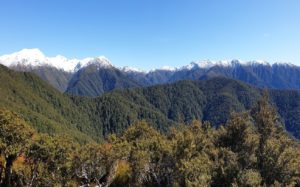
Photo by Derrick Field – view from the top of Blue Range
Kia Ora,
Looking forward to longer, sunnier days, summer and getting out and about in Aotearoa more.
Te Papa Atawhai (DOC) has recently launched Te Kaupapa a Te Papa Atawhai, its new organisational strategy. This puts nature and people at the heart of everything we do. They are connected through our single, united purpose – Papatūānuku Thrives. DOC’s te reo name is a reflection of the Treaty Partnership being at the core of our work. ‘Te Papa’ reflects our relationship with Papatūānuku –the Earth mother, or natural world – and ‘Atawhai’ represents our philosophy of caring for her.
Here in Masterton, we’re all refreshing our skills and learning Te Reo, so we thought of mentioning the many free online training modules available to anyone interested. Here’s the link:
https://www.doc.govt.nz/get-involved/training/online-courses/
Last newsletter introduced the Masterton Biodiversity team, this spring newsletter features a profile on our Community Team here in the Wairarapa.
Enjoy!
BRING BACK THE BIRDSONG
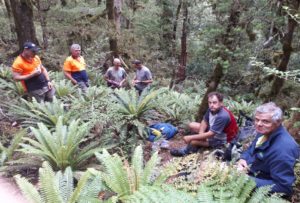
Right on the doorstep of Carterton is the Tararua Forest Park.
The Holdsworth Restoration Trust [HRT] are a group of volunteers, with about 30 regulars, working in an area of the Tararua Forest Park around the Holdsworth campground, and Donnelly Flat.
The area that is being covered encompasses about 1,000 hectares, and the aim is to reduce pest numbers to low levels, not to eliminate them entirely. This would include rats, and to a lesser extent mice, stoats and weasels. By reducing their numbers, native bird and insect species already in the area will be enabled to breed more successfully without being preyed on.
Eventually, the group hopes to have pest numbers within the trapping area at such a low level that they can introduce other native species to the area, such as the North Island Robin.
Chairperson of the HRT, Nigel Boniface, said, “I enjoy being in the outdoors, I love the native birdlife found there, and then the work I do controlling pests is a way to keep fit, enjoy the bush environment, and help the native species”. Using self-resetting A24 traps, which, once in position, need only to be serviced at 6-month intervals, all the jobs are carried out by volunteers, who mostly do the work at weekends, when they are available. They mark the trap locations, carry the traps into place and secure them to a tree, replace the lure, and operate gas cylinders at 6-month intervals.
Currently there are 640 traps in place, about one third of the eventual number of traps they hope to get into the area
Rat monitoring weekends are held two or three times a year and require 12 to 16 helpers on the Saturday and the Sunday.
Gerald Leather is a volunteer who would like to see and hear more birds in the park. “I have visited other parts of New Zealand where intensive trapping seems to have greatly increased the bird population; places where the dawn chorus is deafening”. He hopes they can achieve similar results around the Holdsworth Lodge entry to the Tararua Ranges.
Anyone wanting to volunteer needs to be reasonably fit – there are plenty of hills – have some experience in a bush environment, and an ability to cope with being off track in rough terrain sometimes, with good footwear and clothing, suitable for the conditions. Familiarity with a GPS is useful, but all new volunteers will go out with an experienced volunteer on their first few visits.
Volunteer Annette Beattie said the volunteers were a diverse bunch – “they come from lots of walks of life, have plenty of great stories, cover a wide age range, and are from all parts of the Wairarapa and further afield”. “There’s a heartfelt connection between the Tararua Ranges and many people who live in the Greater Wellington region.”
Gerald said he enjoyed volunteering for the HRT because it “enables me to indulge my passion for off track exploration of the Tararua Ranges, and to enjoy the random beauty of the forest with its very impressive trees and plants and wild streams”.
“A day in the bush is worth 10 in a built-up environment.”
Thanks to Lisa Urbani for the photo and article published in The Midweek on August 1, 2020.
****
A LITTLE ABOUT THE HOLDSWORTH RESTORATION TRUST:
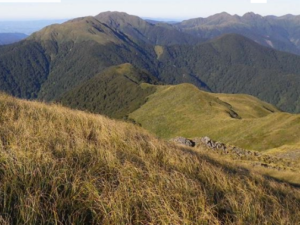
The Trust was formed in December 2018. We have applied to the DOC Community Fund for assistance, and with other donations hope to raise enough money to be able to install 150-200 traps a year for the next few years, as well as having income to renew the lure and gas in each trap every 6 months. So hopefully in 4-5 years we will have pest numbers sufficiently low to look at organizing a transfer of North Island Robin. For Further details have a look at t heir web site: https://holdsworthrestorationtrust.org/
****
APPRECIATION
Special recognition and thanks to the following volunteers who have helped us achieve a lot of catch-up work during the last few months. They have gone out of their way to make contact and let us know they’re “heading up the hill”, is there anything they can do and following up with reports and photos which help us to mark off worked completed and credit Volunteer Hours to our system.
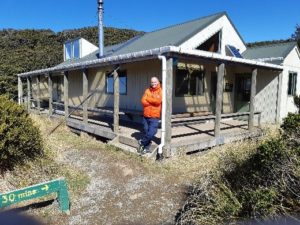
Brett Gillies has made many trips and treks up and around the Western Side of the Tararua Ranges, attending to tracks and vegetation as he walks to varying huts and has offered his volunteering greatness to the Palmerston North office.
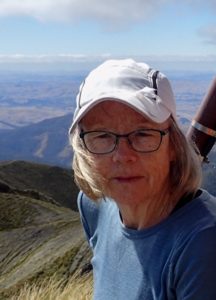
Jenny McCarthy has been actively walking the Tararua Ranges from the Northern Eastern area and has been to various huts, replacing signs, tidying, reporting and sending in some great shots to help record further work required.
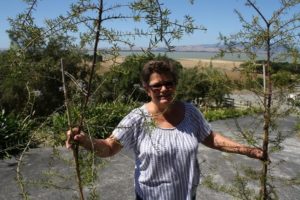
Lesley Christian has been attending to basic maintenance at the Cross Creek Site, Western Lake Site and the Wairongomai reserve, cleaning and caring for the most important sites needed by keen trampers, walkers, cyclists and visitors.
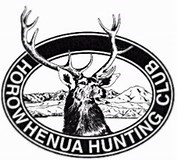
The Horowhenua Hunt Club has worked to have a lockable gate installed on driveway at the Mangahao Dam Houses and made a magnificent job. Have been kept up to date with all the requirements and having been over and inspected can say Great Job and Well Done. The installation and having followed all the processes right down to the last details has been magnificently handled.
****
EXNZFS HUT MAINTENANCE UPDATE FEBRUARY 2020 – SEPTEMBER 2020
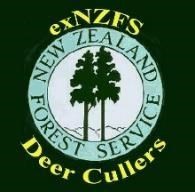
The group has management agreements with DOC for 12 huts and bivouacs; Dundas, Arete Forks, Carkeek, Mid Waiohine, Renata, Elder, Pararaki, and Wairongomai huts and Dracophyllum, Aokaporangi, McGregor and Mid King bivouacs.
Renata Hut renovations continue
The Renata hut team led by ex-Forest Service culler Grant Timlin flew a further seven loads into Renata including half a ton of cement, 250 meters of 4×2, piles, fixings and tools. They flew a couple of extra mattresses to provide for the expected hordes.
The hut was cut off its subfloor using a sabre saw then drove the double perimeter joists in with a big hammer. Four 1.5 ton hydraulic jacks were used to lift the hut while they replaced all the joists, bearers and piles. It went well. Dave Thomas, Aaron Jack and Grant worked for eight days on the subfloor. A couple of weeks later Dave and Grant went back to fit all the stainless steel fixings and attach the bracing and base boards.
The exterior is yet to be painted when some warmer weather arrives.
The Back Country Trust have funded this extensive project to restore a classic tramping hut and provide the public with another option for recreation in the Tararua range.
During the work on this hut, it has been necessary to on the hut roof. ExNZFS members have been through DOC training in working at heights, and on this job, safety harnesses were used by the team.
Our DOC partners have also been very supportive with this project.
As the photos show, weather conditions got a bit chilly at times.
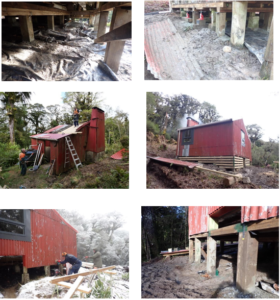
Winchcombe Bivouac
Ex Forest Service culler and hut builder is progressing the construction of Winchcombe Bivouac. Paul built several huts and bivouacs in the forest parks during the 1960s. Including Penn Creek, Dorset Ridge, Wash-pool, Tauanui, Pararaki huts and Mid King and Arete Bivouacs. He also helped build several of the original camps in the Remutaka range that eventually were replaced by huts.
At present clarification with DOC is being sought re building standards. It is hoped to fly the built bivouac to the original site early in the summer this year.
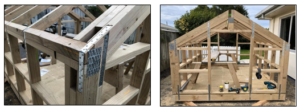
Arete Forks hut
Damage from rot to the rear window needed urgent repairs. The window was brought out when hingers and frame were found to be decaying. Ex Forest Service hut builder Hans Kolinko repaired the window. the Backcountry Trust generously provided emergency funding to cover helicopter hire to get the window repaired and flown back in. JD from Amalgamated Helicopters got us in and out. The hut interior has been cleaned and firewood topped up.
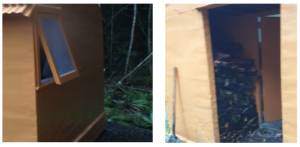
****
DOC MASTERTON – THE COMMUNITY TEAM
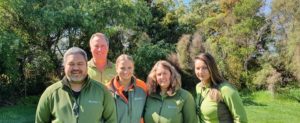
It is the Community Team’s role to involve our treaty partners and the wider community in DOC’s activities and DOC’s contribution to their activities.
Some rangers work with plants and animals. Some work with tracks and structures. Community rangers lead the way on all the other jobs – working with treaty partners, community groups, other organisations and the media. The team processes concession applications, monitors grazing leases, comments on RMA applications and a bunch of other jobs you’d never think of.
****
To end with: a picture taken on a field trip recently – any one care to identify the location?
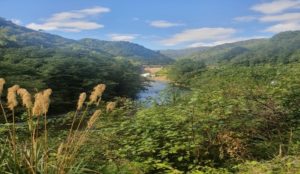
Take care all and thanks for all of your work and communications. Any comments or articles to submit? Please send to wgray@doc.govt.nz – next newsletter will be over Summer – early January 2021.
